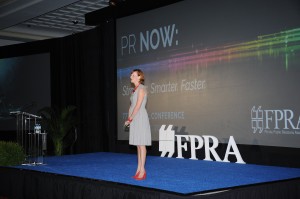By Melissa Link (Central West Coast Chapter)

Some examples of Public Interest Communications driving change over the years:
- The first social justice campaign was developed in the 1760’s by a group of 10 men in Europe who fought for more than 20 years to abolish slavery.
- Drunk driving deaths have dropped more than 50% since the 1980’s.
- 50% of Americans smoked at the height and now only 20% smoke.
- Montgomery Bus Boycott – The mastermind behind the bus boycotts was actually Jo Ann Robinson, a professor at a College in Montgomery. She recognized the most significant ridership was the black people and they had all the power against the bus companies. She and her students printed 35,000 copies of the message and distributed them around the city when Rosa Parks was arrested. Because of her efforts the boycott was sustained for 381 days, leading to eventual desegregation. She knew the message, the audience and how to reach her targets; she waited for the right moment to distribute her call to action. She was so specific and strategic she was able to create lasting change.
We all want to use our skills as communicators for a greater good, achieving significant and sustained positive behavioral change. The key is not awareness but actual change. The other key is that it transcends a single person or organization.
Five Rules for Change Makers
1. Become strategically empathetic
Tell stories about people the way they would tell them. Empathize with your audience by identifying the values of the people whose behavior you are trying to change and see where your values and theirs intersect.
Example: Sport Club do Recife/Increase Organ Donors in Brazil
- Extremely loyal fan base.
- Started where their audience was, not as a worthy cause.
- Created a reason for fans to donate organs to help others. You could be a fan eternally if you donated your organs.
- Results: Over 51,000 fans signed up for a donor card; and the waiting list for heart transplants was eliminated!
2. Communicate in Pictures
According to a Princeton Study, word choice helps us better remember information. We don’t have language for emotion and our feelings are conveyed better through imagery.
Example: Dr. Martin Luther King Jr.’s famous “I Have a Dream” speech.
- No PowerPoint, images or video then – his words still have a lasting impression today.
- His speech is one of the most visual speeches ever written.
3. Use the full palette of emotions
You don’t always have to use the sad, pulling-at-the-heartstrings card to get your message across. Activate other emotions to access memories and inspire people to do new things.
Example – The Prostate Czech – www.theprostateczech.com/
- Funny narrative to help encourage checkups for early detection to help men beat one of the deadliest diseases.
4. Create a call to action that is actionable and advances your cause
- You need to have a call to action – otherwise it’s a lost opportunity for change.
- Example 1 : Montgomery Bus Boycot
– Goal: Desegregation
– Call to action – Don’t ride the bus - Example 2 : www.useonlywhatyouneed.com
– Goal – Conserve Water
– Call to action – Water – use two minutes less – you won’t even notice
5. Tell stories like you mean it.
- Stories are the communication back bone.
- “Pieces of Light: How the New Science of Memory Illuminates the Stories We Tell About Our Pasts,” states that stories are building blocks to our memory; our brains need stories to remember. If there is no story the brain creates one.
- A recent Emory University study shows reading AND hearing a story causes change in our physiology that lasts for days.
- Transportal narrative – we are transported into the heart and mind with the protagonist story – you empathize.
Storytelling Checklist
- Use vivid characters – make your stories about real people.
- Use visual details – visual thinking and relationship to emotion; create pictures with your word choices.
- Follow Freytag’s ARC – if your story doesn’t include a problem and a resolution it’s not a story.
The change you want to create is the flame. Communications is the accelerant on your idea. Fire burns hotter and brighter with an accelerant. Imagine that power being applied to what you want to change. Unleash a new generation of change-makers.
Additional resources and information on the Frank Project: http://frank.jou.ufl.edu
Connect: @aechristiano

Frank and Betsy Karel Endowed Chair in Public Interest Communications, Professor – Department of Public Relations, University of Florida
Ann Searight Christiano is the Frank Karel Chair in Public Interest Communications in the College of Journalism and Communications at the University of Florida. She curates frank, an annual gathering of people who use strategic communications to drive change, and is building a curriculum in the discipline at UF. Christiano came to UF from the Robert Wood Johnson Foundation, where she developed strategies to support the foundation’s investment in reducing violence, promoting play and improving long-term care.
